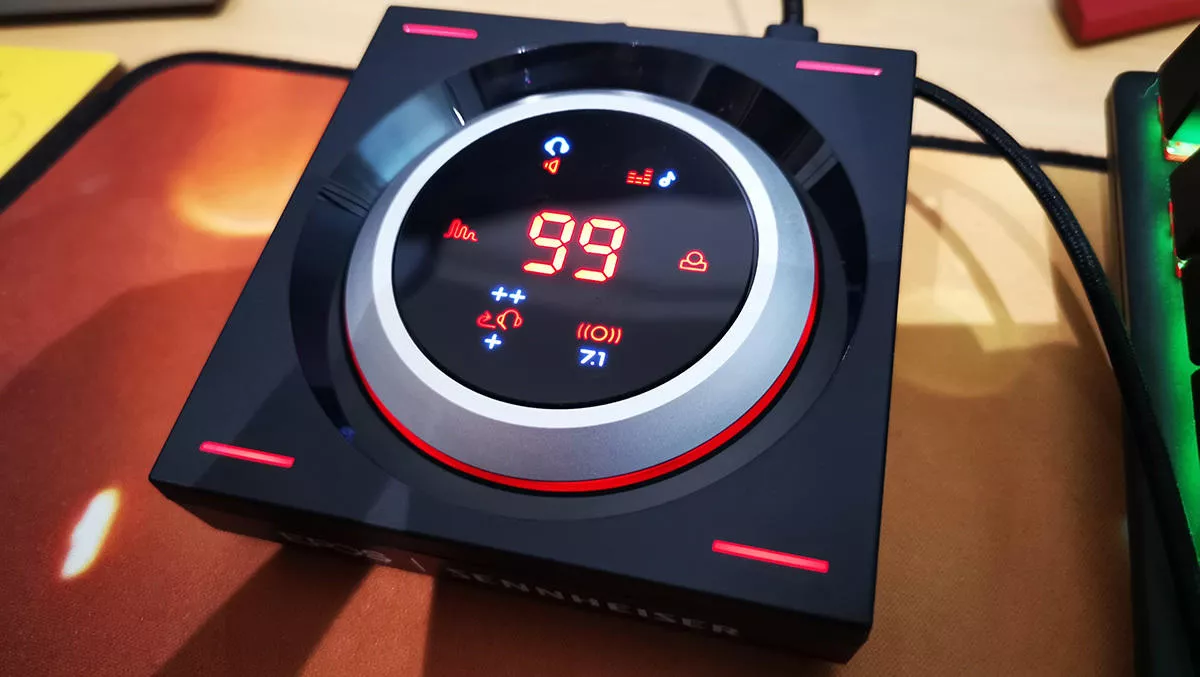
Hands-on review: EPOS Sennheiser GSX 1200 Pro audio amplifier
External soundcards like the EPOS Sennheiser GSX 1200 Pro can turn any half-decent wired headset into an audio extravaganza. The GSX 1200 Pro is a one-stop solution, as it can also output to desktop speakers and well as a headset, switchable with one button press.
In the box is the GSX 1200 Pro unit, a USB cable for connecting to your PC/Mac, and an audio cable for linking the device, in series, to other GSX 1200 Pros for a local chat network. Unfortunately, apart from a tiny bit of paper with some rudimentary set-up instructions, a decent manual was not included.
The set-up should've been easy, but it did not go to plan. There were two factors in play. The first was that the volume controllers weren't working properly and second was the devices inability to render in 7.1 surround.
The GSX 1200 Pro should be connected straight into the back of the PC and not a hub. It even had issues plugged into the front of the test PC. I also had to go into the Windows 10 sound control panel and set the GSX 1200 Pro Main Audio as the default device, as well as set the GSX 1200 Pro Communication Audio as the default communications device.
To stop the error message when setting 7.1 sound I had to reduce the sound quality to 16-bit, 48000 Hz. 24-bit studio sound is only compatible with 2.0 stereo. Two very easy solutions that really should've been better documented. From here on, though, it was plain sailing.
The back of the GSX 1200 Pro has two audio sockets for the ChatLink cable in/outs, The USB input, Speaker output, mic input and headset out. There's a little flap underneath, that when pulled out tilts the face of the device towards the user.
The top of the device consists of a metallic-looking radial dial for the volume, with a touch-sensitive display in the middle. The red illumination dims when not in use, but lights up again when you wave your hand above it.
The centre of the unit's display has the volume level in big digits. Around the face are a number of icons which, when pressed, activate functions.
The output can be switched between speakers and headset with one tap of the icon. The unit has four EQ settings: default, esport, music and story. There's an icon for changing the output from 2.0 to 7.1. The virtual speakers can be adjusted to favour the front, rear, or normal. The side-tone can be selected from none, low or high- very nice if you like to hear your voice when you talk. There are also three environmental audio profiles: the default and most accurate, outside/open space and inside/enclosed space.
On the sides of the unit, there are dials to control the chat input and output levels. The face of the device also has four thin rectangular lights in each cornet that are actually buttons for four customisable profiles.
I paired the GSX 1200 Pro with Epos' GSP 601 wired headset. It's a stylish favourite of mine. I turned the volume dial of the headset right up to the max for full volume control from the GSP 1200 Pro.

I cannot overstate just how useful it is to have all your audio controls at arm's reach. There's no need to open apps or fidget with settings. You want to crank up the volume, you just turn the dial. If you want to switch from listening to music to playing a game, just tap the dial.
The GSX 1200 Pro gives all this functionality to any headset that can be plugged into the device. You can turn your run-of-the-mill headset into a 7.1 surround sound extravaganza and add that all-important sidetone when chatting.
The audio output to the GSP 601 is crisp and clear. Even when turned up the max, there was no distortion. Of course, a lot of the credit goes to GSP 601, but the sound card is the device creating this audio exceptionally played back by the Epos headset. For gaming, the GSX 1200 Pro is excellent. especially the 7.1 audio which really immerses you in the action. Similarly, with music, the surround sound places to right in the heart of the audio.
EPOS Sennheiser GSX 1200 Pro audio amplifier offers desktop access to your PC or Mac audio with easy-to-use settings. Coupled with a decent headset, gamers and audiophiles, alike, with be able to enjoy a superior audio experience.


